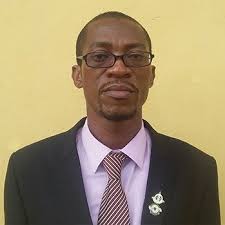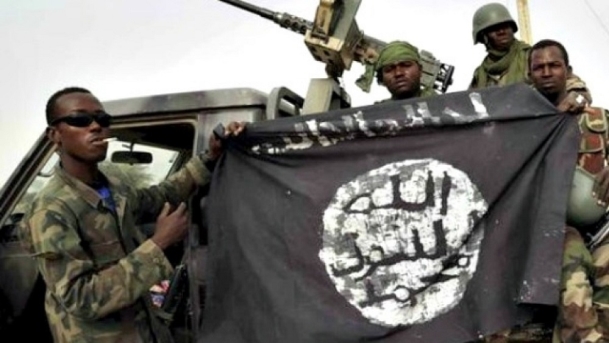
The Nigerian Army has recently initiated a new military operation in the northeast region of the country and around Lake Chad to eradicate the remaining Boko Haram militants. Major General David Ahmadu, army chief of Training and Operations, said the operation would last four months and involve the deployment of additional six army brigades and other military assets in Borno state, where the insurgents remain active.(1) Boko Haram insurgency is believed to have claimed at least 100,000 lives, displaced more than 2.6 million people, caused pain to over 52, 311 orphans and 54,911 widows, and led to about $9 billion worth of damage.(2) UNICEF blames the militant group for killing around 2,295 teachers and destroying more than 1400 schools destroyed since the conflict started nearly nine years ago. Boko Haram waged a short-lived uprising surged in violence under President Goodluck Jonathan's administration, and has grown resilient under President Muhammadu Buhari's administration. This paper examines the trend of Boko Haram’s violence, and aims at explaining the group, societal, state and international dynamics that have shaped its rise and decline.
Since 2009, Boko Haram’s campaign of terror has been the biggest security challenge facing Nigeria, although the escalating clashes between pastoralists and farmers across the country struggle to eclipse the insurgency. The group's ideological objective has evolved from simple advocacy for Islamic puritanism in northern Nigeria to the creation of the Islamic State in West Africa and Lake Chad region in particular. Its campaign of violence started as a less organised and less sophisticated uprising in 2002; but by 2015 it has acquired the infamous title of the “world's deadliest terrorist organisation”.(3)
Some observers find it difficult to see a strategy in Boko Haram’s activities, or to know whether strategy is involved at all, especially since Abubakar Shekau, the movement’s leader, appears to be unbalanced. Shekau once boasted on social media that he enjoyed ‘killing anyone that God commands me to kill the way I enjoy killing chickens and rams’. As Virginia Comolli wrote in her book “Boko Haram: Nigeria’s Islamist Insurgency”, the death in childbirth of one of Shekau’s wives ‘triggered some existing but hitherto repressed psychiatric problem: he became so violent that it was necessary to put him in chains.’ At the time of the kidnappings, he claimed that the girls were slaves and would be sold in the market because ‘Islam permits slavery.’(4)
How and when Boko Haram’s campaign of terror ends have become a matter of serious concern in Nigeria and beyond.(5) Subsequent governments of Nigeria have been committed to a series of efforts to contain Boko Haram’s violence. Other affected countries in the Lake Chad region - Chad, Cameroon and Niger - have joined the war against Boko Haram, complemented by series of supportive initiatives by the international community.
The Rise of Boko Haram
Boko Haram, meaning Western education is forbidden, is the brand name for Jama’atu Ahlis Suna Lidda’awati Wal Jihad (People Committed to the Propagation of the Prophet’s Teachings and Jihad), which was renamed the Wil?yat al-Isl?miyya Gharb Afr?qiyyah (or the Islamic State West African Province (ISWAP) in March 2015. The group belief that Western influence is responsible for state failure, political corruption, underdevelopment, poverty, inequality and injustice in northern Nigeria, and considered Islamic revivalism as the only way to redemption.(6)
The weak institutional capacity of the Nigerian state in providing public goods and lack of governance are at the root of Boko Haram’s emergence, transformation, and audacity. The deep level of underdevelopment in northern Nigeria and the associated dichotomy between Westernisation and Islamism also stimulated the crisis. Thus, Boko Haram emerged as a non-conformist group under the leadership of Muhammed Yusuf in 2002. In addition to proselytization and anti-state mobilisation, the group engaged in series of confrontations with the security forces between 2002 and 2009, which climaxed in the short-lived July 2009 uprising under President Umaru Musa Yar Adua's administration.(7)
The uprising was brutally suppressed by state security forces, during which hundreds of its members were murdered and Yusuf extra-judicially killed by the police. Abubakar Shekau succeeded Yusuf as Boko Haram’s leader, transforming the group into a clandestine organisation that adopted the strategy of terrorism and insurgency from 2010. Under Shekau’s brutal leadership, the Boko Harm has sustained a deadly insurgency that overwhelmingly targeted civilians involving assassinations, assaults, bombings, abductions, invasion of border communities, and seizures and control of territory in Nigeria.
Boko Haram developed capacity for insurgency with recruits and sometimes conscription from Nigeria, Cameroon, Niger, Chad and beyond. It professed support for Al Qaida in 2010 and later pledged allegiance to the Islamic State in Iraq and Syria (ISIS) in 2015. Boko Haram members were known to have received training from Al Qaida in Islamic Maghreb (AQIM), which operates across the Sahel and North Africa, and from Al Shabaab in East Africa. Besides self-produced bombs and projectiles, they sourced weapons internationally from trans-Sahel trafficking groups that have developed amidst the ruin of Gadhafi regime in Libya, and raiding of armoury of police stations and military bases in Nigeria and Cameroon. A number of local politicians provided support for Boko Haram with the aim of gaining some political advantage in Nigeria.
Overtime, the militant group has diversified its funding sources from foreign terrorist groups, bank robbery, cattle rustling, drug trafficking, extortion, engagement in ‘front’ businesses, collection of levies, and kidnapping for ransom. Boko Haram has made over US$10 million from kidnapping for ransom, considering US$3.75 million allegedly paid by Cameroonian government between 2013 and 2014, and €7 million by the government of Nigeria between 2017 and 2018.(8)
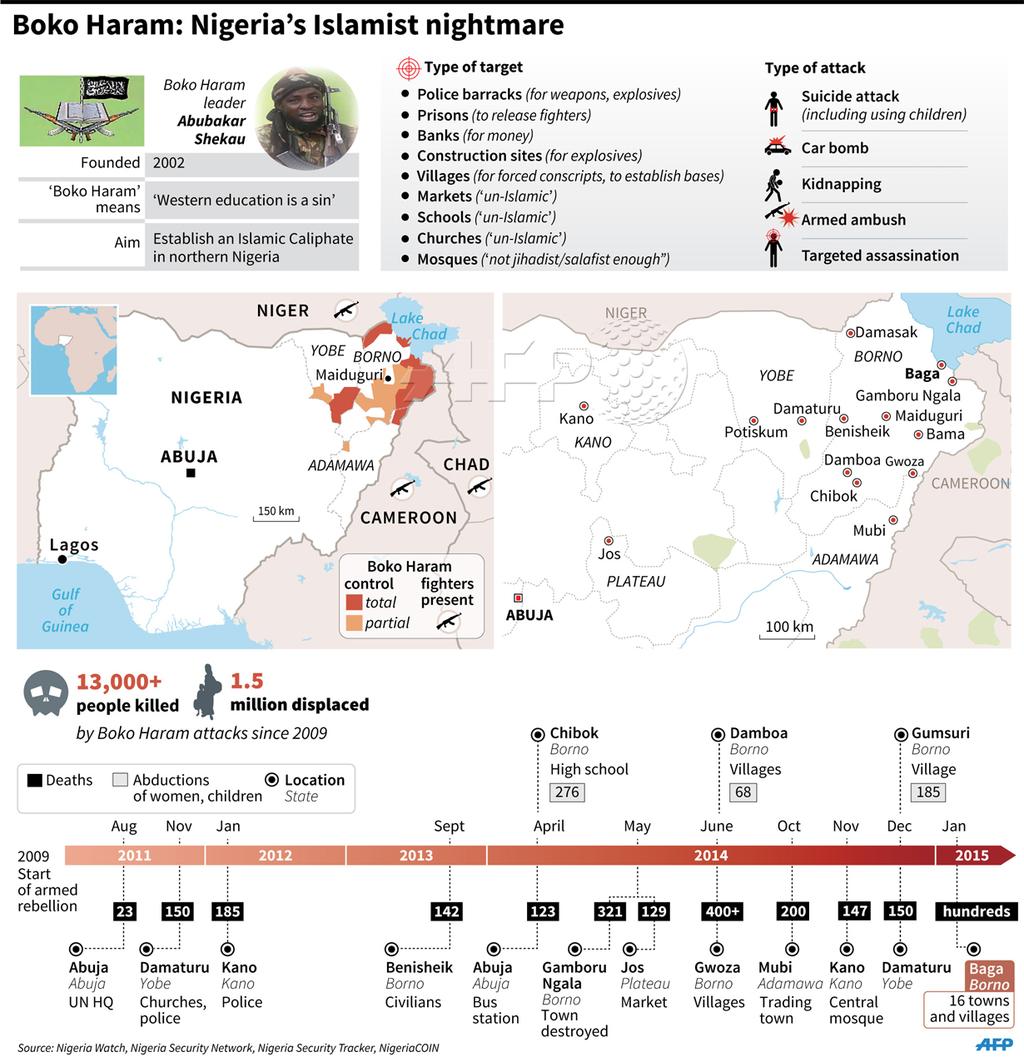 |
| [AFP] |
Trends of Boko Haram’s Violence
Boko Haram has been sophisticated in launching its violent attacks, and was responsible for 1639 terrorist attacks, with 14436 fatalities, 6051 wounded victims and 2063 hostages captured in Nigeria.(9) The abduction of 276 school-girls from Chibok in April 2014 by the group has been the largest single incident so far, triggering an international campaign to ’Bring back our Girls'. At the same time, the Nigerian government claimed that the crisis affected 14.8 million people, and caused 23,461 death, over 5,000 missing persons, 2 million displaced persons (IDP) and 1.66 trillion naira economic loss in north-eastern Nigeria.(10) Between 2009 and 2017, Armed Conflict Location and Event Database (ACLED) documented 2445 offensive, defensive or strategic incidents that involved Boko Haram, with record of 28,168 fatalities in Nigeria (see Figure 1). At the peak of the insurgency in early January 2015, the insurgents controlled about 20,000 square miles of territory in Nigeria - an area the size of Belgium.
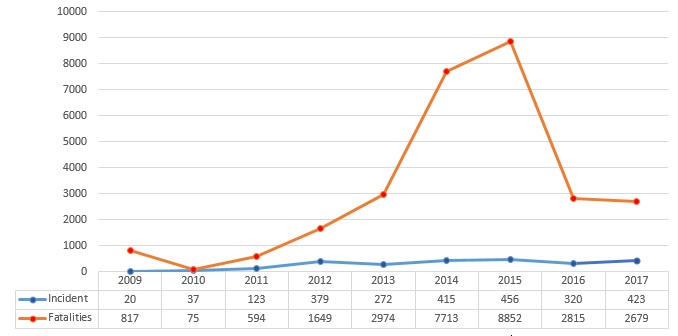 |
| Figure 1: Patterns of Boko Haram’s violence and Associated Fatalities, 2009-2017 [Adapted from ACLED](11) |
There are claims that Boko Haram’s violence and associated cost are underreported. This is possibly the reason why most available public data often reported fatalities from Boko Haram’s violence to be between 20,000 and 30,000. As of mid-2017, the government of Borno State stated that Boko Haram’s crisis was responsible for destruction of N1.9 trillion ($5.2 billion) worth of properties, including one million houses and 5,000 classrooms in the state.(12) Boko Haram has abducted thousands of people much as it has destroyed thousands of property.
The group's capacity for territorial control and large-scale attacks however has begun to wane since 2015. As Figure 1 highlights, Boko Haram crisis was at its peak in 2015. GTD shows that there was a decline in Boko Haram attacks by 8 percent, hostages by 23 percent and fatalities by 30 percent between 2014 and 2015. Noticeable decline in violence started under President Muhammadu Buhari, as improvement in the counterinsurgency (COIN) operations of the Nigerian military, efforts by the Multinational Joint Task Force (MNJTF), and the splintering of the group led to the recovery of swathes of previously occupied territory, loss of thousands of its fighters, and freeing of hundreds of abductees. However, the group has proven resilient despite repeated claims by President Buhari's administration that Boko Haram is "technically defeated, "terribly degraded" and "completely decimated".
The group has carried out more than 60 attacks, which claimed over 200 lives across the Lake Chad region in the first three months of 2018.(13) On 19 February 2018, the ISWAP faction of Boko Haram kidnapped one hundred and five (105) school-girls from the Government Girls Science and Technical College (GGSTC), Dapchi, Yobe State, in a fashion similar to the April 2014 abduction of Chibok schoolgirls. As the time of writing, the group appears mainly focused on carrying out suicide bombings and kidnapping.
Behind the Decline
There are several factors responsible for the decline of Boko Haram as a violent group in Nigeria. One of them is the lingering internal crisis within the group. The contention for the leadership of Boko Haram between Shekau, Khalid al-Barnawi, and Mamman Nur caused factionalism in the group after the death of Yusuf, and was crucial to the formation of Ansaru otherwise known as Jama’atu Ansarul Musilimina fi Biladin Sudan (Defender of Islam in the Land of Black Africa) in January 2012.(14) His would-be-successors had disagreement over doctrine, ideology, targets and tactics caused a major split in August 2016, leading to the emergence of at least three factions with control over several cells. One faction is led by Abubakar Shekau. The other faction, ISWAP, is headed by the ISIS-appointed Abu-Musab al-Barnawi, the son of Mohammed Yusuf. There is also speculation of a third group led by Mamman Nur who is allied with al-Barnawi's faction but not part of the Islamic State.(15)
There are other smaller groups like Bukar Mainok’s faction. Although tense factionalism in Boko Haram can be linked to disagreement among top commanders over doctrine, targets and tactics of Islamic jihadism, it should be noted that war of attrition among them has weakened their membership strength. The cracks in the group enabled some of the insurgents to surrender or change side, or engage in dialogue with the government. Another important factor is the diminishing support base of Boko Haram. In fact, the group’s popularity has decline with the rise in its indiscriminate violence. Prior to 2009, the movement was alleged to have about 280,000 followers.(16) At the peak of its campaign of violence, its membership strength range from 15,000 to 50,000.(17) Initially, most political and traditional elites from the north sympathised with Boko Haram, justifying its emergence and suggesting dialogue or political concession as solution to the problem.(18)
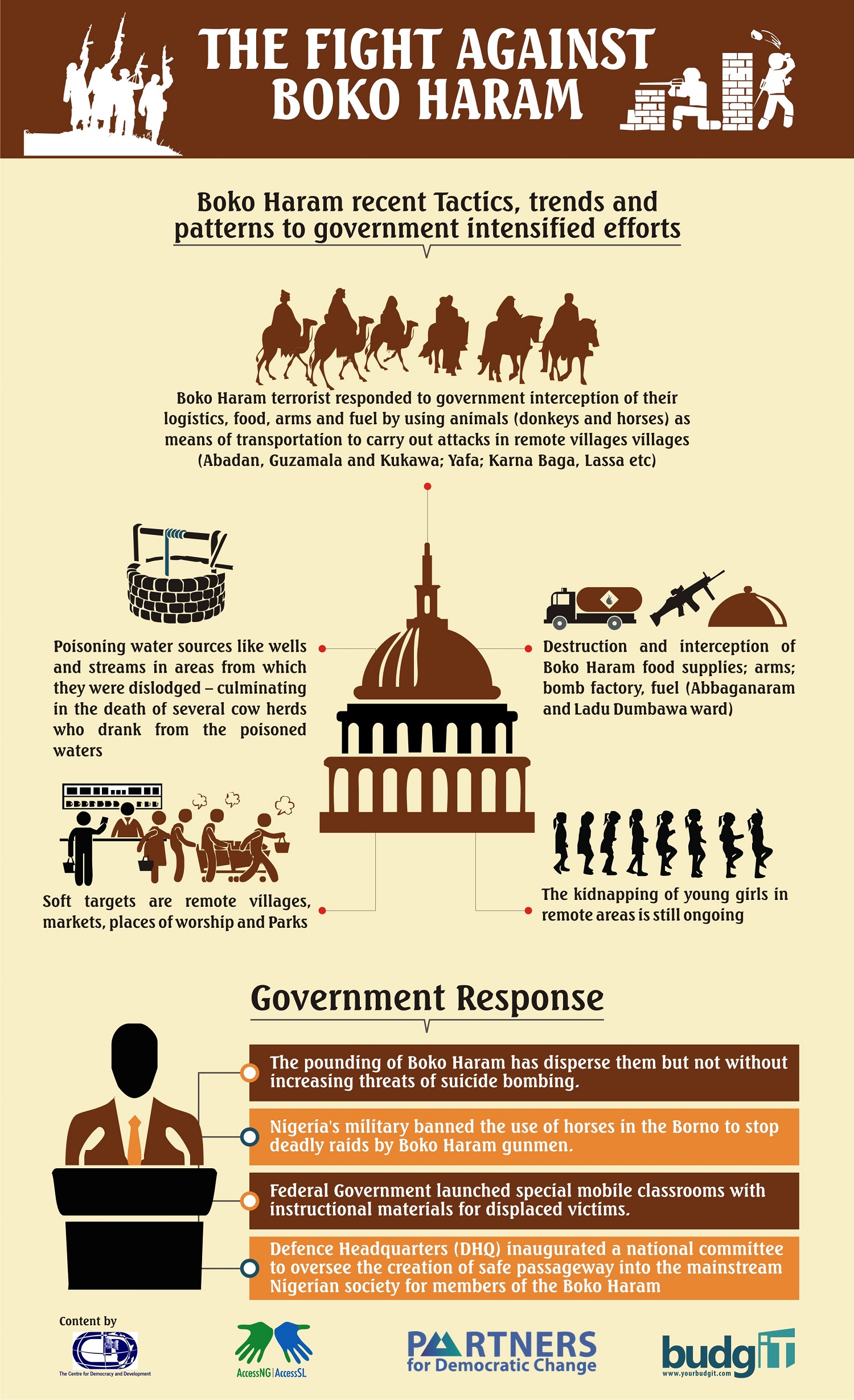 |
| [AFP] |
The Nigerian Army complained of the community support for the group and launched punitive actions against some communities. Meanwhile, extreme brutality accompanied territorialisation of Boko Haram’s violence. Some analysts have argued that the local elites and the masses who have been caught between the devil (Boko Haram) and the deep blue sea (the Army), switched their support to the military as their safety hang in the balance. Consequently, a large number of the Nigerian youth formed the Civilian Joint Task Force (CJTF), to support the efforts of security forces in the war against Boko Haram.(19)
Given the initial support of the group, the Nigerian military suffered a series of setback due to its harsh approach, trans-border nature of the crisis, weak cooperation of the neighbouring countries, inconsistency in policy response and politicisation. Concerted efforts in addressing some of these concerns and unprecedented troop surge turned the tide against Boko Haram from 2015. Troops deployed for COIN operations in the northeast was raised from about 3,000 in 2012 to 8,000 in 2013, 20,000 in 2014, 25,000 in early 2015 and 40,000-50,000 in 2017.(20) Consequently, Nigeria’s military forces have been successful in the fight against the group, killing its members, destroying insurgent bases, disrupting their logistic networks, and freeing captives. Nevertheless, the federal government resorted to dialogue, ransom payment, and prisoner swap to secure the release of 103 abducted Chibok school-girls in 2017 and 104 Dapchi school-girls in 2018.
The Nigerian authorities announced an amnesty offer to Boko Haram members. The government's penchant for negotiation with the insurgents has attracted criticism, cynicism and suspicion from the public. There was a great deal of controversy about the manner the Dapchi school-girls were audaciously abducted and later triumphantly returned in broad daylight amidst cheers from the locals. On 21 March 2018, one of Nigeria's leading Newspapers, The Guardian, conducted online poll to gauge the public opinion on the release of the Dapchi girls. It sought to ascertain if with the release of 101 Dapchi girls, the Buhari administration should be (a) applauded, (b) quizzed (c) re-elected, or (d) sacked. Data in figure 2 shows the result of 464 respondents that voted as at 3:50 pm that day.
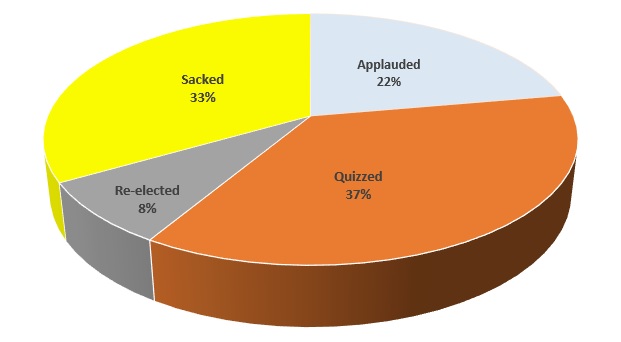 |
| Figure 2: Public Reaction to President Buhari's Negotiated Release of Abducted Dapchi School-girls |
The fact that more respondents voted that President Buhari should be quizzed (37%) or sacked (33%) reflected deep expression of disappointment with his administration. Tellingly, it conveys a sense of suspicion rather than appreciation of government's efforts. Another factor remains significant on the decline of Boko Haram. It is the regional military collaboration in the campaign against the militant group. Nigeria declared a war against Boko Haram with a full-scale military campaign in 2013, and was joined by Cameroon in 2014 as well as Niger Republic and Chad in 2015. The other three countries committed about 15,000 troops against Boko Haram in early 2015. These four countries joined by Benin Republic establish a unified force of 8,700 strength’s MNJTF, which take-off in 2016 to patrol common borders and curb the trans-border activities of the insurgents. These frontline states received limited financial and intelligence support, training and weapon supply from across the world to the advantage of their COIN capabilities.
Conclusion
Despite repeated claims that Boko Haram has been degraded, decimated, and defeated, the group has retained headlines with a series of attacks against both military and civilian targets. Given Boko Haram's antecedent, reduction in its capacity to seize territory and launch large-scale attacks are perhaps the most significant and measurable indicators of its gradual decline. Whether the decline is terminal or temporary is hard to guess; but, should be a matter of concern to authorities in the Lake Chad area.
As pressure mounts on ISIS's strongholds in Iraq, Syria and Libya, the Sahara-Sahel region of Africa may be an attractive destination for fleeing foreign fighters who may join up with any of the Boko Haram factions in the future. In such a scenario, the presumed decline may prove to be transient rather than terminal. To prevent the resurgence of Boko Haram, the Nigerian government needs to invest heavily in human development, especially in the northeast region, to address the key drivers of the insurgency such as poverty, marginalisation, and other vulnerabilities that extremist ideologues have exploited in their pursuit of recruitment and radicalisation. It is important for the state security forces to sustain the COIN operations in an accountable and professional manner, while improving capabilities to gather actionable intelligence that would inform proactive, timely and effective responses. Moreover, there is dire need for robust cooperation between Nigeria and the neighbouring states in the fields of intelligence sharing and concurrent border patrol operations. The international community should increase its support to the affected states in the Lake Chad region.
(1) Rafiu Ajakaye, “Nigeria announces military operation to rout Boko Haram”, Anadoul Agency, April 21, 2018 https://aa.com.tr/en/africa/nigeria-announces-military-operation-to-rout-boko-haram/1124309
(2) Sani Tukur, “Shocking Revelation: 100,000 killed, two million displaced by Boko Haram Insurgency, Borno Governor Says,” Premium Times, February 13, 2017
(3) Institute for Economics and Peace, (2015). Global Terrorism Index. New York: IEP.
(4) Adewale Maja-Pearce, “Where to begin?” London Review of Books, Vol. 40 No. 8 · 26 April 2018 https://www.lrb.co.uk/v40/n08/adewale-maja-pearce/where-to-begin
(5) Hakeem Onapajo, “Has Nigeria Defeated Boko Haram? An Appraisal of the Counter-Terrorism Approach under the Buhari Administration,” Strategic Analysis, 41(1), (2017): 61-73.
(6) Lere Amusan and Samuel Oyewole, “Boko Haram terrorism in Nigeria: A Reflection on the Failure of Democratic Containment,” Politeia, 33(1) (2014): 35-59.
(7) Freedom Onuoha, “The Islamist challenge: Nigeria’s Boko Haram crisis explained,” African Security Review, 19(2) (2010): 54-67.
(8) Samuel Oyewole, and Freedom Onuoha “Boko Haram’s Abduction of Dapchi Schoolgirls: Context, Controversy and Concerns,” African Security Review (forthcoming).
(9) Global Terrorism Database (GTD), 1970–2015. Available at http://www.start.umd.edu/gtd
(10) “Rebuilding the North East: The Buhari Plan Volume I,” Prepared by the Presidential Committee on the North East Initiative (PCNI), June 2016.
(11) Armed Conflict Location & Event Data Project (ACLED), 1997-2018. Available at http://www.acleddata.com
(12) Premium Times, “Boko Haram destroyed one million houses, 5,000 classrooms, N1.9 trillion properties in Borno-Official,” August 8, 2017.
(14) Jacob Zenn, “Leadership Analysis of Boko Haram and Ansaru in Nigeria,” CTC Sentinel 7(2) (2014), pp. 22–29.
(15) Freedom C. Onuoha, “Split in ISIS-Aligned Boko Haram Group,” Al Al Jazeera Center for Studies, Reports, 27 October 2016.
(16) N.D. Danjibo, Islamic Fundamentalism and Sectarian Violence: The ‘Maitatsine’ and ‘Boko Haram’ Crises in Northern Nigeria, Ibadan: Institute of African Studies, 2009.
(17) Samuel Oyewole, “Boko Haram: Insurgency and the War against Terrorism in the Lake Chad Region,” Strategic Analysis, 39(4), (2015): 428–432.
(18) Tunde, "Govt must dialogue with Boko Haram, says Senator, The Guardian, 27 December 2012, http://thenationonlineng.net/govt-must-dialogue-with-boko-haram-says-senator/
(19) Alexander Thurston, Boko Haram: The History of an African Jihadist Movement. New Jersey, Princeton University Press, 2017, p.207.
(20) Samuel Oyewole, “Making the Sky Relevant to Battle Strategy: Counterinsurgency and the Prospects of Air Power in Nigeria,” Studies in Conflict & Terrorism, 40(3), (2017): 211-231.
